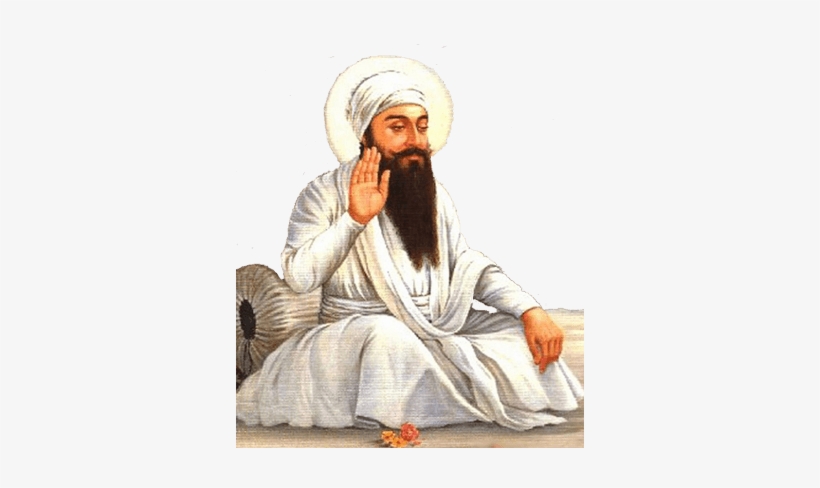
Most Mughal historians considered Arjan's execution as a political event, stating that the Sikhs had become formidable as a social group, and Sikh Gurus became actively involved in the Punjabi political conflicts.[14][40] A similar theory floated in the early 20th-century, asserts that this was just a politically-motivated single execution.[41] According to this theory, there was an ongoing Mughal dynasty dispute between Jahangir and his son Khusrau suspected of rebellion by Jahangir, wherein Arjan blessed Khusrau and thus the losing side. Jahangir was jealous and outraged, and therefore he ordered the Guru's execution.[11][12][7][13] But according to Jahangir's own autobiography, most probably he didn't understand the importance of Sikh gurus. He referred to Arjan as a Hindu, who had "captured many of the simple-hearted of the Hindus and even of the ignorant and foolish followers of Islam, by his ways and manners...for the three or four generations (of spiritual successors) they had kept this shop warm." The execution of Arjan marks a sharp contrast to Jahangir's tolerant attitude towards other religions such as Hinduism and Christianity.[42][43] The Gurdwara Dera Sahib in Lahore, Pakistan, commemorates the spot where Guru Arjan Dev is traditionally believed to have died. The Sikh tradition has a competing view. It states that the Guru's execution was a part of the ongoing persecution of the Sikhs by Islamic authorities in the Mughal Empire,[17] and that the Mughal rulers of Punjab were alarmed at the growth of the Panth.[15][40][44] According to Jahangir's autobiography Tuzk-e-Jahangiri (Jahangirnama) which discussed Arjan's support for his rebellious son Khusrau, too many people were becoming persuaded by Arjan's teachings and if Arjan did not become a Muslim, the Sikh Panth had to be extinguished.[40][note 1] In 1606 CE, the Guru was imprisoned in Lahore Fort, where by some accounts he was tortured and executed,[15][45] and by other accounts, the method of his death remains unresolved.[40] The traditional Sikh account states that the Mughal emperor Jahangir demanded a fine of 200,000 rupees and demanded that Arjan erase some of the hymns in the text that he found offensive. The Guru refused to remove the lines and pay the fine which, the Sikh accounts state, led to his execution.[46] Some Muslim traditional accounts such as of Latif in 19th-century states that Arjan was dictatorial, someone who lived in splendour with "costly attire", who had left aside the rosary and the clothes of a saint (fakir).[47] Shaikh Ahmad Sirhindi cheered the punishment and execution of Arjun, calling the Sikh Guru an infidel.[48][note 2] In contrast, Mian Mir – the Sufi friend of Arjan, lobbied when Jehangir ordered the execution and the confiscation of Arjan's property, then got the confiscation order deferred, according to Rishi Singh.[51] Some scholars state that the evidence is unclear whether his death was due to execution, torture or forced drowning in the Ravi river.[12][52][53] J.S. Grewal notes that Sikh sources from the seventeenth and eighteenth-century contain contradictory reports of Arjan's death.[54] J. F. Richard states that Jahangir was persistently hostile to popularly venerated saints, not just Sikhism.[55] Bhai Gurdas was a contemporary of Arjan and is a noted 17th-century Sikh chronicler.[56] His eyewitness account recorded Arjan's life, and the order by Emperor Jahangir to torture the Guru to death.[57] A contemporary Jesuit account, written by Spanish Jesuit missionary Jerome Xavier (1549–1617), who was in Lahore at the time, records that the Sikhs tried to get Jahangir to commute the torture and death sentence to a heavy fine, but this attempt failed.[58] Dabistan-i Mazahib Mobad states Jahangir tortured Arjan in the hopes of extracting the money and public repudiation of his spiritual convictions, but the Guru refused and was executed.[59] Jerome Xavier, in appreciation of the courage of Guru Arjun, wrote back to Lisbon, that Arjan suffered and was tormented.[3] According to the Sikh tradition, before his execution, Arjan instructed his son and successor Hargobind to take up arms, and resist tyranny.[60] His execution led the Sikh Panth to become armed and pursue resistance to persecution under the Mughal rule.[15][61] Michael Barnes states that the resolve and death of Arjun strengthened the conviction among Sikhs that, "personal piety must have a core of moral strength. A virtuous soul must be a courageous soul. Willingness to suffer trial for one's convictions was a religious imperative".[3] Guru Arjan hunting while mounted on horseback with a hawk. Painting from Faizabad, circa 1760. There are several stories and versions about how, where and why Arjan died.[62][63][64] Recent scholarship[65][66] have offered alternative analyses, wary of "exaggerating fragmentary traces of documentary evidence in historical analysis". The alternate versions include stories about the role of Arjan in a conflict between the Mughal Emperor Jahangir and his son who Jahangir suspected of trying to organize a patricidal coup. An alternate version highlights the role of a Hindu minister of Jahangir named Chandu Shah. He, in one version, takes revenge on Arjan for not marrying his son Hargobind to Chandu Shah's daughter. In another Lahore version, Chandu Shah actually prevents Arjan from suffering torture and death by Muslims by paying 200,000 rupees (100,000 crusados) to Jahangir, but then keeps him and emotionally torments him to death in his house.[67] Several alternative versions of the story try to absolve Jahangir and the Mughal empire of any responsibility,[63][68] but have no trace or support in the documentary evidence from early 17th century, such as the records of Jesuit priest Jerome Xavier and the memoirs of Jahangir.[14][16][69]
